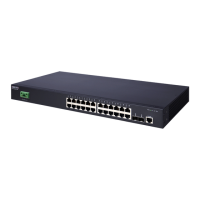Chapter 23
| Quality of Service Commands
– 627 –
Example
This example creates a policy called “rd-policy,” uses the class command to specify
the previously defined “rd-class,” uses the set phb command to classify the service
that incoming packets will receive, and then uses the police flow command to limit
the average bandwidth to 100,000 Kbps, the burst rate to 4,000 bytes, and
configure the response to drop any violating packets.
Console(config)#policy-map rd-policy
Console(config-pmap)#class rd-class
Console(config-pmap-c)#set phb 3
Console(config-pmap-c)#police flow 10000 4000 conform-action transmit
violate-action drop
Console(config-pmap-c)#
police flow This command defines an enforcer for classified traffic based on the metered flow
rate. Use the no form to remove a policer.
Syntax
[no] police flow committed-rate committed-burst
conform-action {transmit | new-dscp}
violate-action {drop | new-dscp}
committed-rate
- Committed information rate (CIR) in kilobits per second.
(Range: 0-10000000 kbps or maximum port speed, whichever is lower)
committed-burst
- Committed burst size (BC) in bytes.
(Range: 4000-16000000 bytes)
conform-action - Action to take when packet is within the CIR and BC.
(There are enough tokens to service the packet, the packet is set green).
violate-action - Action to take when packet exceeds the CIR and BC. (There
are not enough tokens to service the packet, the packet is set red).
transmit - Transmits without taking any action.
drop - Drops packet as required by violate-action.
new-dscp - Differentiated Service Code Point (DSCP) value. (Range: 0-63)
Default Setting
None
Command Mode
Policy Map Class Configuration
Command Usage
◆ You can configure up to 16 policers (i.e., class maps) for ingress ports.
◆ Policing is based on a token bucket, where bucket depth (i.e., the maximum
burst before the bucket overflows) is by specified the
committed-burst
field, and
the average rate tokens are added to the bucket is by specified by the
